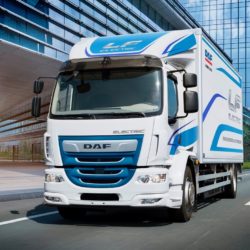E-trucks to reach financial tipping point in 2028

For many companies, electric trucks will not become financially attractive until at least 2028. Nevertheless, the e-truck will break through sooner due to the introduction of zero-emission zones in 2025. By 2030, as many as one in four new trucks are expected to be electric, according to a report by Dutch bank ING.
The Dutch road network is set to change dramatically, as preparations get underway to introduce between 30 and 40 zero-emission urban zones from 2025 onwards. Battery-electric trucks would be the most suitable solution in these zones. Prices of e-trucks are starting to come down, but for many companies they will not make financial sense until 2028 at the earliest. According to ING, this poses the risk that carriers will continue using diesel vehicles in the transition phase after 2025.
Following on from passenger cars and buses, the electrification trend is now spreading to trucks too. Battery-electric heavy goods vehicles are already being tested in practice and several European truck manufacturers are planning a large-scale launch of various models from 2021 onwards. Electric trucks are ideal for use within a hundred-kilometre radius and have high engine efficiency. Therefore, ING regards them as the most suitable vehicles for meeting the Climate Agreement’s target of zero-emission urban distribution from 2025.
Electric trucks not cheaper than diesels until 2028
In view of the small margins in road transport, the sector is focused on cost efficiency. E-trucks are currently 3.5 times more expensive than diesels, plus carriers require their own fast-charging stations. On the upside, they have much lower maintenance costs, ING states. Although the price of electric trucks will fall significantly between now and 2030, even with subsidies it is expected to take until 2028 for such a truck to be financially attractive based on 60,000km a year.
Due to the high initial outlay, electric trucks become more attractive as the annual mileage increases. If the truck can be used for 100,000km a year rather than 60,000km, the financial tipping point will be reached in 2025. Redesigning the logistics network to include more regular routes and short distances is another way to help bring the tipping point forward, according to the authors of the report.
Machiel Bode, Sector Banker for Transport and Logistics at ING: “Electric trucks will remain more expensive than diesel trucks in the short term, but we are rapidly heading towards zero-emission urban distribution and ever-more companies are aiming to reduce emissions. That’s why it’s important for carriers to consider how electric driving can impact their specific business model and to make the transition together with their clients.”
Newcomers can disrupt the market
The ING researchers identify one uncertainty on the path to 2030 as being the potential arrival on the European market of manufacturers such as Nikola and Tesla. With specially developed electric models, these newcomers could cause disruption and a faster drop in prices. This would make electric trucks financially attractive sooner, of course. A similar thing could happen if the upcoming toll scheme would favour electric trucks or if the charging infrastructure would benefit from tax relief.
Although sales of electric trucks are still slow, the e-truck will definitely achieve a breakthrough in the next decade, concludes the report. The introduction of zero-emission urban distribution will boost the demand for e-trucks after 2025, plus the truck manufacturers themselves are actively pushing the shift. It will be possible to stick to diesel for a while, but being a frontrunner also offers carriers and shippers other benefits. Sales will pick up as the business case becomes more attractive, and e-trucks are forecast to account for approximately a quarter of the market by 2030, according to ING.










